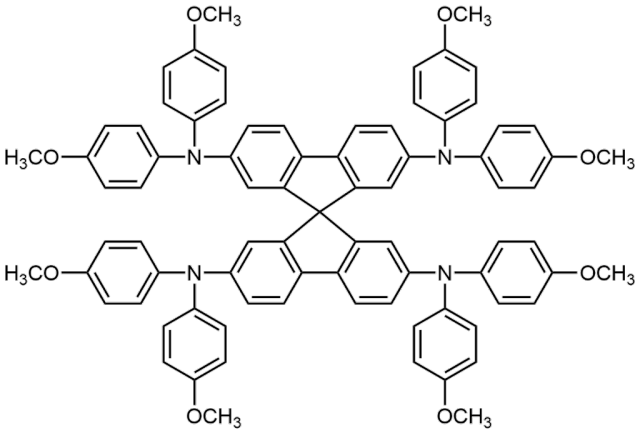The content on our website is provided solely for general informational purposes. It should not be considered, nor is it intended to provide advice or recommendations for the purchase, sale, or trade of any products or services. Importantly, the information presented does not constitute an offer to sell or a solicitation of an offer to buy any product.
Please be aware that the availability of our products may vary across different markets due to regulatory restrictions or other considerations. Consequently, not all products or services may be available in your region or country. For specific inquiries regarding the availability and pricing of any product, please contact us at sales@noctiluca.eu.
General information
-
Name:
Spiro-OMeTAD
-
Full name:
2,2',7,7'-Tetrakis[N,N-di(4-methoxyphenyl)amino]-9,9'-spirobifluorene
-
CAS number:
207739-72-8
-
Chemical formula:
C81H68N4O8
-
Molecular weight:
1225.43 g/mol
-
Absorption:
λmax = 306 nm, 385 nm in DCM
-
Photoluminescence:
λmax = 429 nm in DCM
-
HOMO/LUMO:
HOMO = -5.0 eV, LUMO = -2.1 eV
-
Synonyms:
Spiro-MeOTAD, N2,N2,N2′,N2′,N7,N7,N7′,N7′-Octakis(4-methoxyphenyl)-9,9′-spirobi[9H-fluorene]-2,2′,7,7′-tetramine
-
Classification:
Organic light-emitting diodes, White OLED materials, Perovskite-based photodiodes materials (PPD), Solid-state hole transport materials for DSSC, Solar cells
-
Purity:
Sublimed: >99.5% (HPLC)
-
Melting point:
>360 °C (0.5% weight loss)
-
Appearance:
White to pale yellow powder
Spiro-OMeTAD: A Cornerstone in Organic Electronics
Spiro-OMeTAD, or 2,2′,7,7′-Tetrakis[N,N-di(4-methoxyphenyl)amino]-9,9′-spirobifluorene, is a groundbreaking material in the realm of organic electronics. Utilized primarily as a hole transport layer (HTL) material, Spiro-OMeTAD plays a crucial role in the efficiency and performance of various organic-inorganic electronic devices, including perovskite solar cells (PSCs), organic light-emitting diodes (OLEDs), and polymer-based organic solar cells (OSCs).
The Structure and Properties of Spiro-OMeTAD
Understanding the molecular structure of Spiro-OMeTAD is key to appreciating its functionality. With its spirobifluorene core, the compound exhibits excellent thermal stability and solubility in common organic solvents. Its high hole mobility and efficient charge transport properties make Spiro-OMeTAD an ideal choice for HTL applications.
Our Spiro-OMeTAD boasts a purity level of over 99.5% as confirmed by HPLC analysis, ensuring optimal performance in electronic devices.
Key Features of Spiro-OMeTAD
- High Hole : Spiro-OMeTAD is renowned for its high hole mobility, a critical factor in enhancing the performance of hole transport layers in solar cells and OLEDs. This property ensures efficient charge transport, contributing to the overall device efficiency.
- Superior Thermal : The robust thermal stability of Spiro-OMeTAD guarantees consistent performance under varying temperature conditions. This makes it an ideal material for devices requiring long-term stability and reliability.
- Versatile Applications: Spiro-OMeTAD’s versatility extends beyond perovskite solar cells. It is also a crucial component in other organic electronic devices like OLEDs and organic field-effect transistors (OFETs), highlighting its broad applicability.
- Effective Charge Transport: Spiro-OMeTAD exhibits excellent charge transport properties. This is vital for extracting and channeling positive charges in solar cells and OLEDs, thereby improving their efficiency and performance.
The Role of Spiro-OMeTAD in Advanced OLEDs
In the dynamic field of OLED technology, the pursuit of materials that enhance efficiency, longevity, and reduce energy consumption is critical. Spiro-OMeTAD stands out in this context with its unique molecular structure and hole transport properties. As a vital component in OLEDs, Spiro-OMeTAD plays a significant role in optimizing device performance and extending their lifespan. Its ability to efficiently transport holes and maintain stability under operational conditions aligns perfectly with the needs of advanced OLEDs. This ensures that OLED devices are not only more effective but also demonstrate improved durability and energy efficiency, marking a substantial contribution to the evolution of OLED technology.
Conclusion
Spiro-OMeTAD is more than just a chemical compound; it’s a key enabler in the field of organic electronics, paving the way for more efficient, stable, and high-performing devices. As we continue to explore its potential, Spiro-OMeTAD remains at the forefront of technological advancement in solar energy and OLED technology.
